Role of Metadata Management in Enterprise AI: Importance, Challenges & Getting Started
Share this article
McKinsey research observes that generative AI (GenAI) could add trillions in value — $2.6 trillion to $4.4 trillion annually. However, this potential could be unrealized without well-managed metadata that assures the AI-readiness of your data assets.
Effective metadata management is not just the cornerstone of success in enterprise AI, but also a guardian of data security, privacy, and compliance. Metadata is crucial to creating ethical, valuable, and sustainable AI recommendations.
This article explores the role of metadata management in enterprise AI, highlights its benefits, and discusses considerations to get started.
Table of contents #
- What is the role of metadata management in enterprise AI?
- Common challenges in enterprise AI
- How to ensure metadata management in enterprise AI: Getting started
- The role of metadata management in enterprise AI is critical
- Related Reads
What is the role of metadata management in enterprise AI? #
Good, trustworthy, comprehensible data is the fundamental prerequisite to building AI models and providing accurate, reliable outcomes from those models. If garbage goes in, garbage comes out.
When you train new AI models, you need accurate, complete, relevant data with useful details, such as data asset names, descriptions, classifications, and related assets.
Despite ensuring the quality and reliability of your input data, if the outcomes aren’t as expected, then you must reverse-engineer the problem to understand what went wrong. That requires proper context on the data asset’s origins, ownership, transformations, etc.
For example, if the chatbot you’ve built is offering inaccurate, weird answers to your questions, you want to understand what training data was fed to it and what information it’s using to reach those odd conclusions.
In both situations, you need relevant metadata. Metadata management lends context, structure, and organization to the vast amounts of data spread across an enterprise’s data estate. It’s also the key to guaranteeing AI-readiness of your data estate.
How does metadata management ensure data readiness for AI? #
AI-ready data is understandable, trustworthy, and has the right context. That’s why metadata management is at the heart of ensuring data readiness for AI.
VP Analyst Ehtisham Zaidi echoes similar sentiments at the 2024 Gartner D&A Summit’s opening keynote:
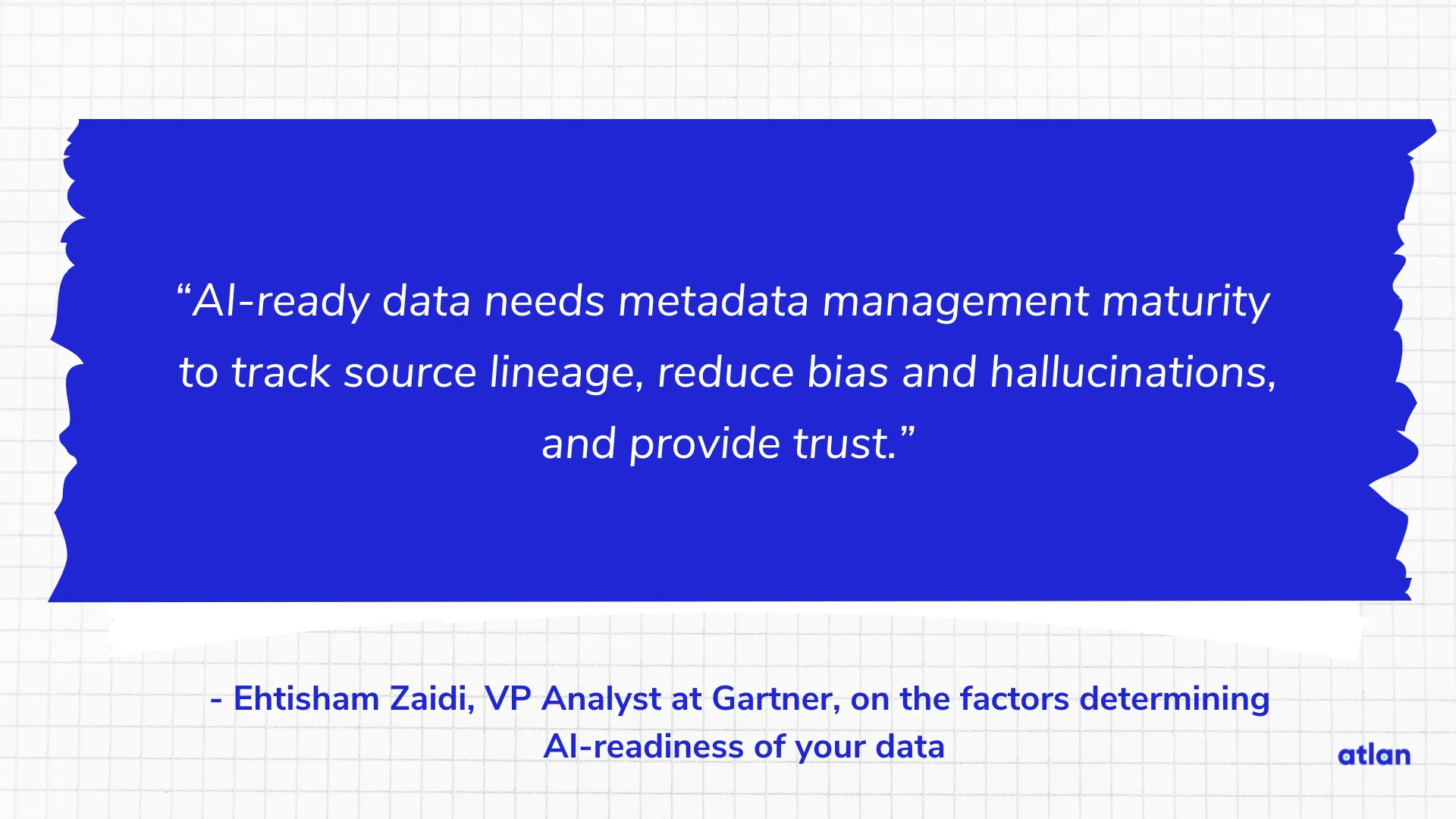
AI-ready data needs metadata management maturity to track source lineage, reduce bias and hallucinations, and provide trust - Source: Ehtisham Zaidi, VP Analyst at Gartner.
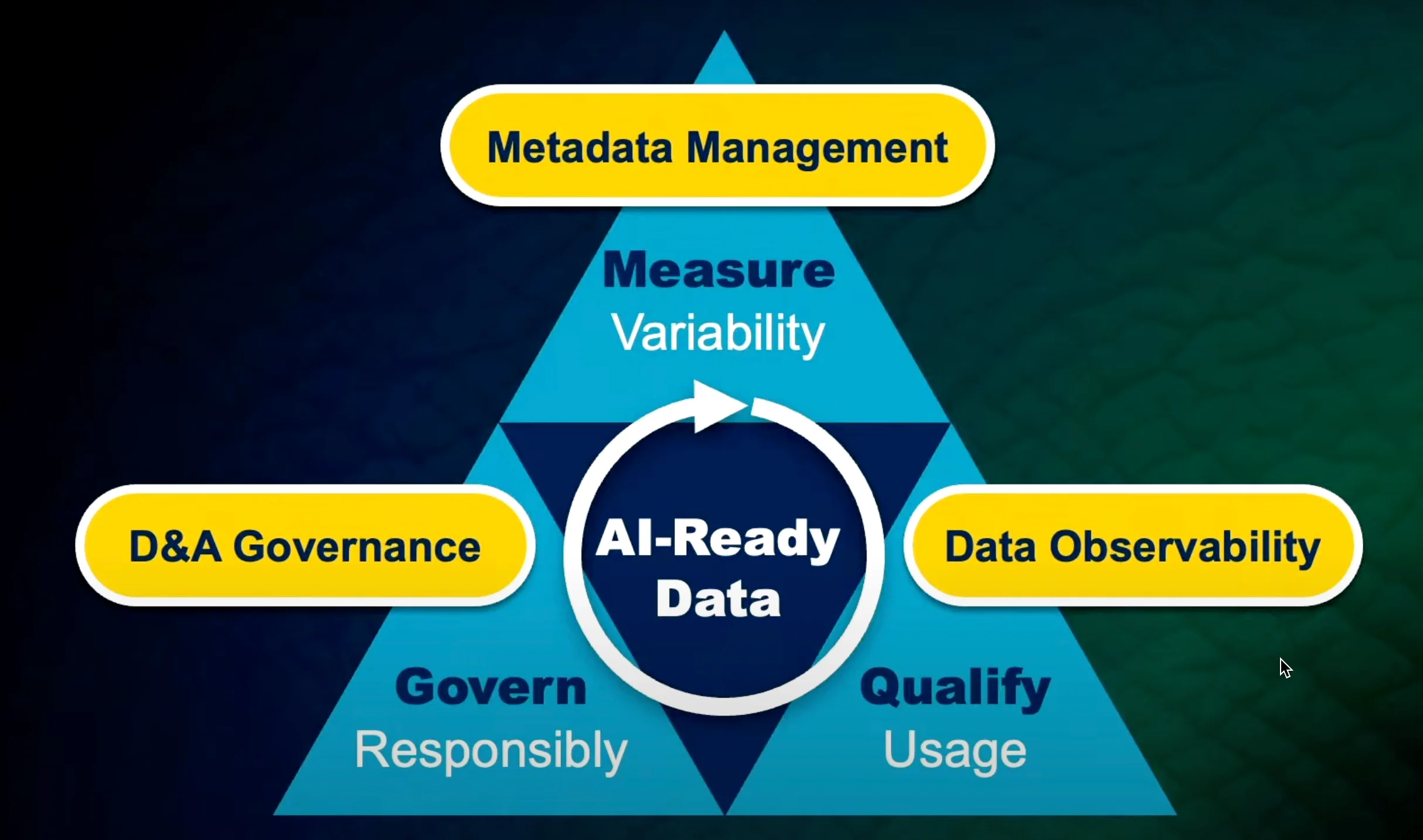
The role of metadata management in AI-readiness of enterprise data, according to Gartner - Source: YouTube.
Benefits of metadata management in enterprise AI #
By capturing and organizing the right metadata, enterprises gain a comprehensive view of their data landscape, enabling them to:
- Trace the origins and ownership (i.e., the source lineage) of data used for training and ensure its quality, which provides accurate, relevant, and valuable outputs
- Identify (and collaborate with) the teams responsible for model development and deployment, thereby ensuring accountability
- Understand how the model’s output impacts various stakeholders, which improves transparency and trust in its outcomes
- Comply with data privacy and regulatory standards, thereby ensuring secure, responsible, and ethical AI
As Artyom Keydunov, Co-founder and CEO at Cube, succinctly puts it:
“To operate correctly and execute trustworthy actions, it (LLM) needs to have enough context and semantics about the data it consumes; it must understand the metrics, dimensions, entities, and relational aspects of the data by which it’s powered.”
To understand the impact of metadata management on AI model outcomes, let’s explore the most common challenges in enterprise AI, from data quality issues to bias and hallucination risks.
After that, let’s understand how metadata management helps overcome such challenges, which will underline its benefits in extracting value from enterprise AI models.
Common challenges in enterprise AI #
The most common challenges plaguing enterprise AI deployments are:
- No single source of truth
- Data quality issues
- Lack of data context and lineage
- Compliance and regulatory concerns
- Bias and hallucination risks
Let’s get into the specifics.
1. No single source of truth #
Enterprise data is scattered across data sources, tools, dashboards, and spreadsheets. Consolidating and analyzing this data can be painful and time-consuming.
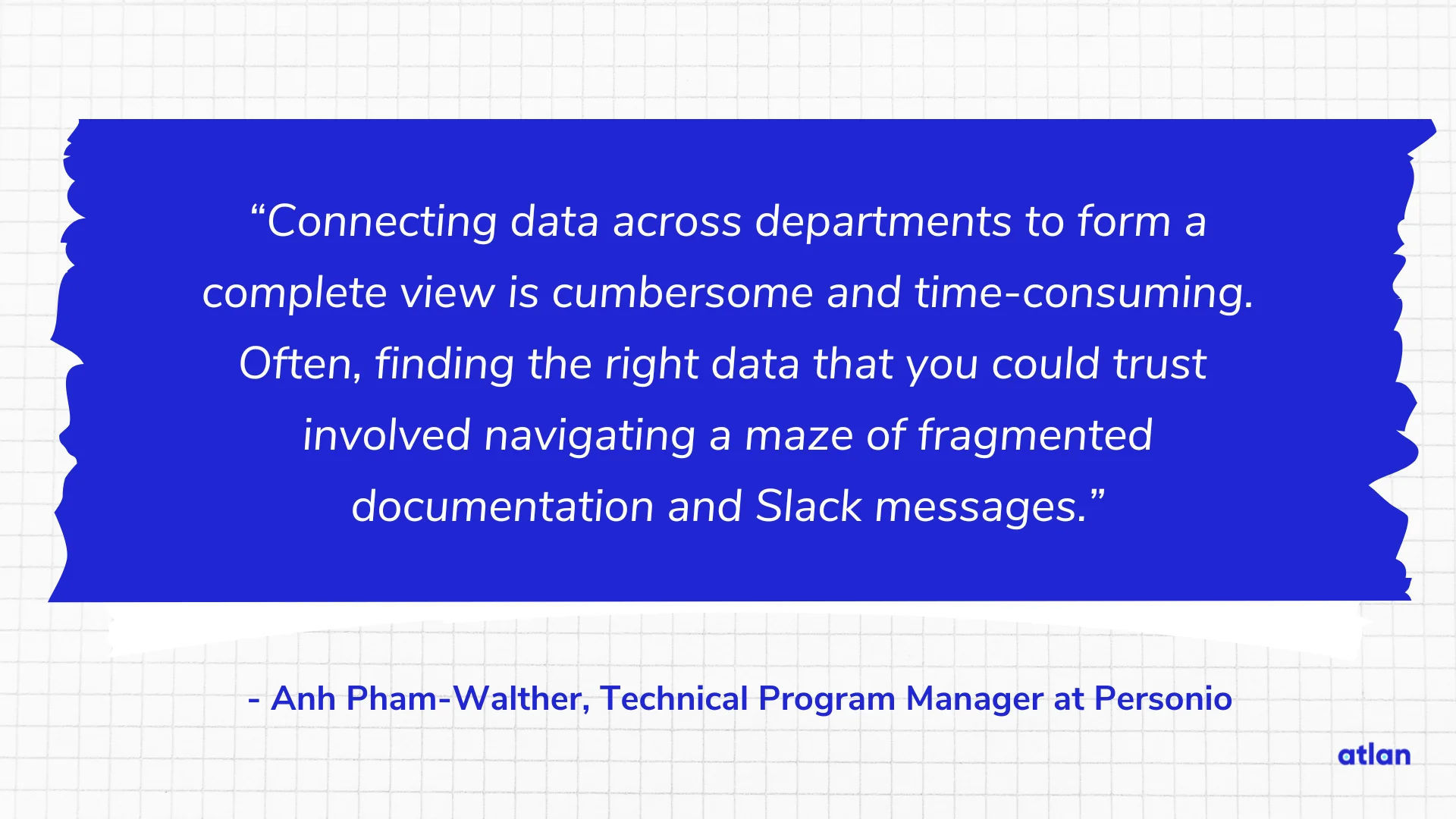
Connecting data across departments to form a complete view is cumbersome and time-consuming - Source: Atlan.
Without a single source of truth that centralizes metadata, the risk of errors and inconsistencies in AI models increases.
2. Data quality issues #
AI systems deal with large volumes of data across systems and tools. This can lead to data quality issues, such as missing values, duplicates, outliers, and anomalies.
For instance, when sourcing data from multiple systems, conflicting values for the same attribute (different time zones, units of measure, or variations in product names) can crop up. These inconsistencies can lead to inaccuracies in AI model predictions.
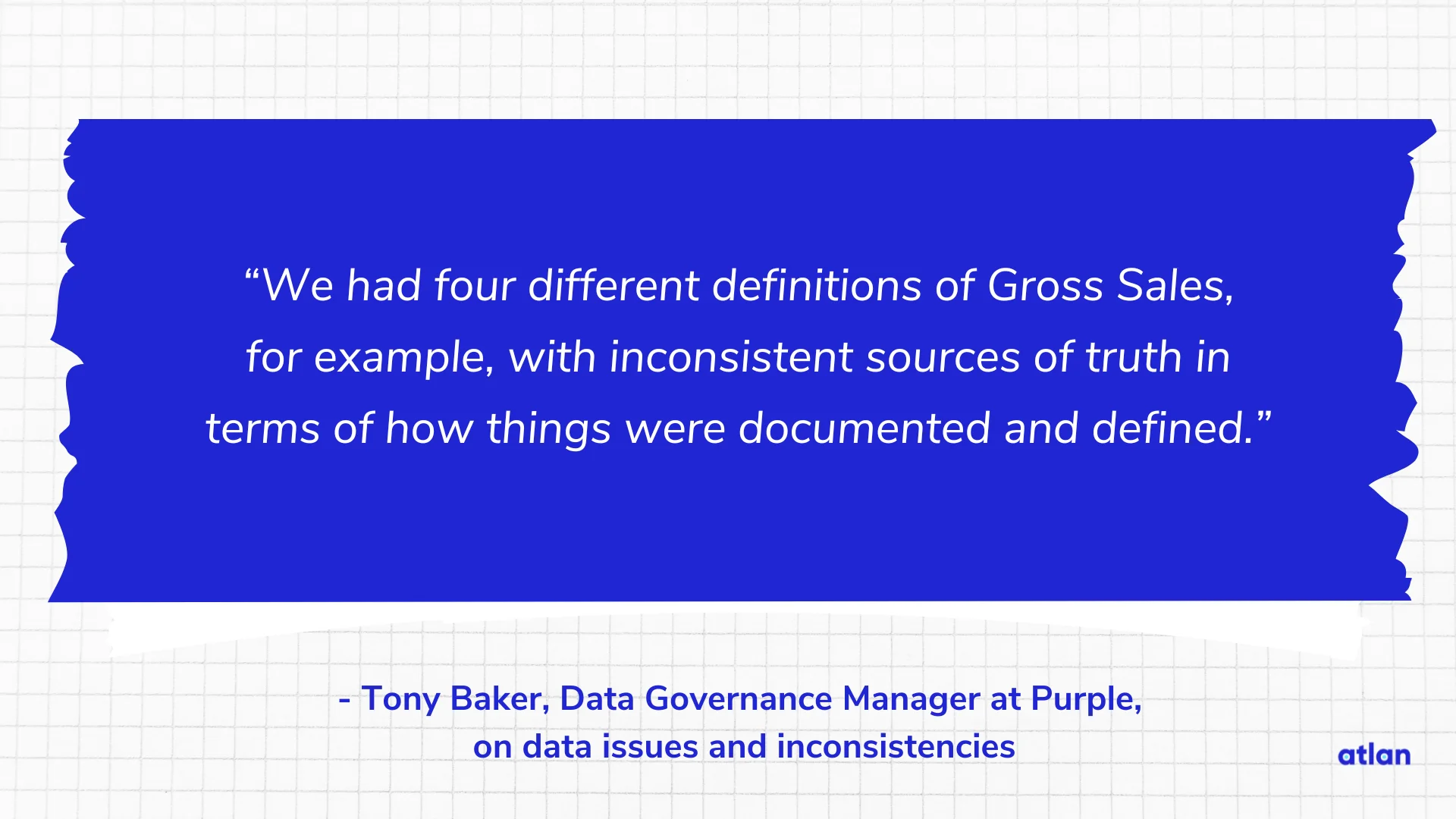
Tony Baker, Data Governance Manager at Purple, on data issues and inconsistencies - Source: Atlan.
3. Lack of data context and lineage #
When it comes to a lack of data context, there are two avenues to look at:
- The ability of AI systems to understand and interpret your data
- The ability of data teams to understand how AI model outcomes were derived
AI systems can only understand what’s well-documented. However, data teams (and organizations in general) have a habit of passing down tribal knowledge (shared experiences, observations) verbally, rather than documenting or structuring it.
AI systems cannot connect the dots with undocumented tribal knowledge. They need rich, high-quality metadata to make sense of your data and deliver the outcomes you seek.
Secondly, as organizations mature, they collect and store data faster than ever, and their data sources become more diversified.
In such situations, tracing the origins and transformations of data becomes difficult, especially without an infrastructure that maps end-to-end, cross-system lineage and extracts context automatically.
Without this context, understanding how AI model inputs were derived is challenging.
Here’s how Brian Kim, Data Analyst II at Foundry, describes this issue:
“One of the most prominent issues that I personally face is with data exposure. We have rich data. However, people outside of the data team are uncertain of where (this data is) and what data we can provide.”
4. Compliance and regulatory concerns on AI transparency and explainability #
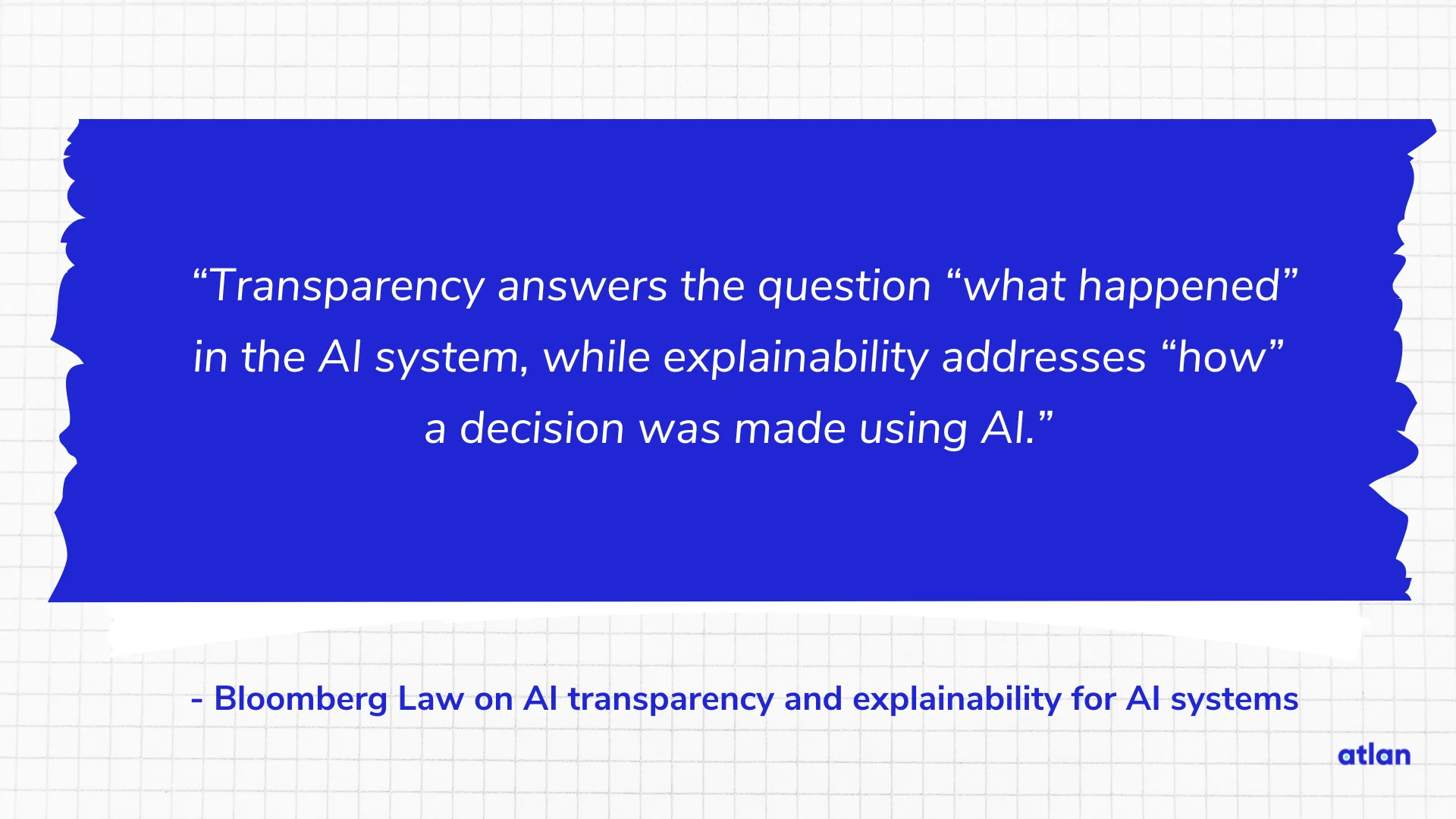
Transparency answers the question “what happened” in the AI system - Source: Bloomberg Law on AI transparency and explainability for AI systems.
Organizations are accountable for the decisions made by their AI systems — understanding and explaining how models were developed, validated, and monitored.
Recent developments in data-specific regulations also expect you to guarantee the explainability of your AI models — provide explanations for the decisions made by AI. For instance, Andrew Smith, Director, FTC Bureau of Consumer Protection, highlights:
“You must know what data is used in your model and how that data is used to arrive at a decision. And you must be able to explain that to the consumer.”
5. Bias and hallucination risks #
AI models are infamous for generating nonsensical or false information (i.e., hallucination) and biased results. Cognitive scientist Douglas Hofstadter had a conversation with ChatGPT’s earliest avatar, where the model churned out gibberish:
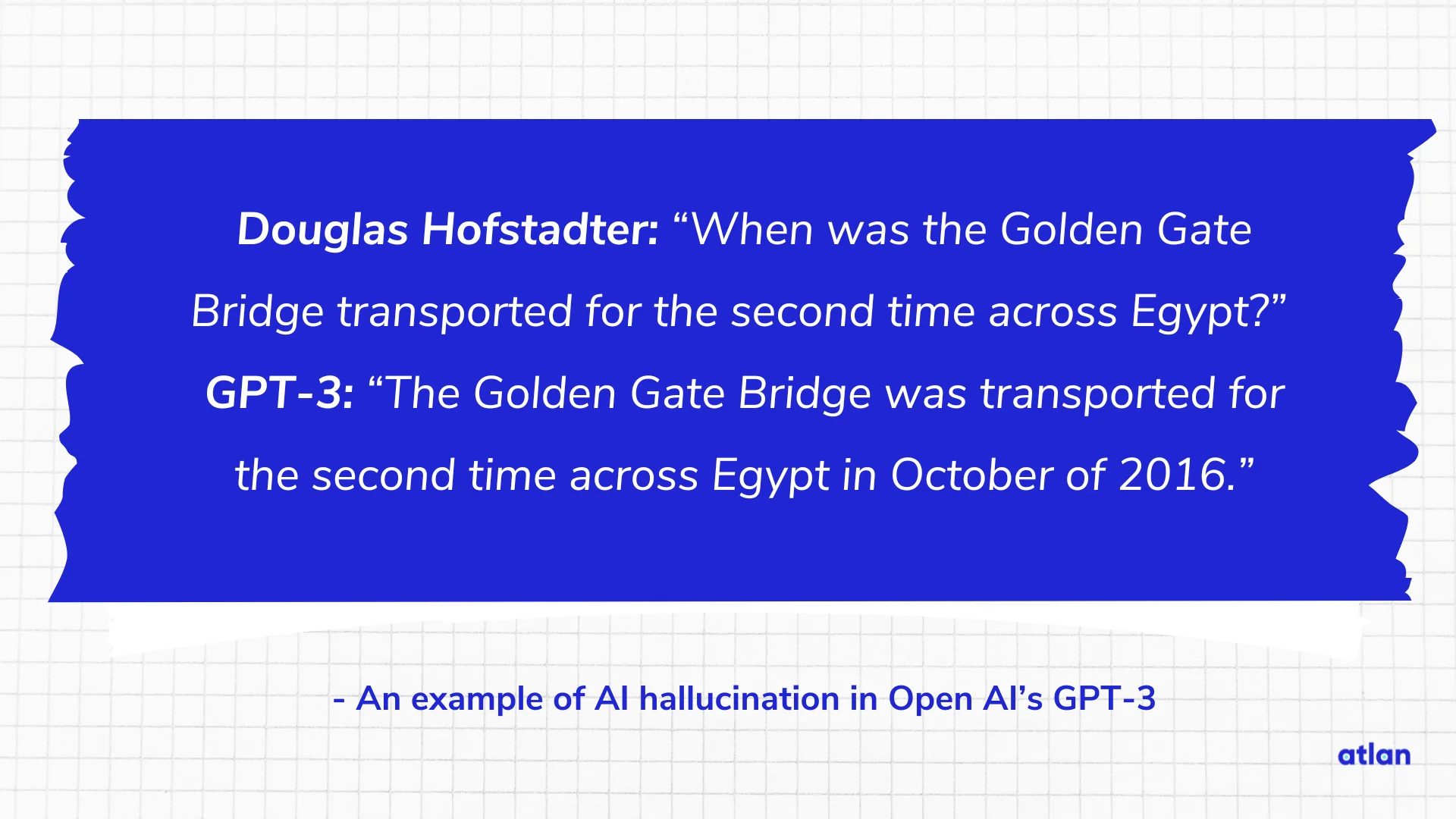
An example of AI hallucination in Open AI’s GPT-3 - Source.
Hofstadter attributes the hallucination to GPT-3’s lack of context. He observes:
“There are no concepts behind the gpt-3 scenes; rather, there’s just an unimaginably huge amount of absorbed text upon which it draws to produce answers.”
The right context (in the form of metadata) can assure AI systems accurately interpret the right data. It also equips AI models to understand and flag anomalies, thereby reducing bias and hallucination risks.
Addressing the above challenges is vital for successfully deploying AI in enterprise tech stacks. If not tackled, these challenges can lead to inaccurate models, unreliable results, and potential legal and ethical issues.
Let’s look into the role of metadata management in overcoming the above challenges in enterprise AI.
How metadata management overcomes the challenges in enterprise AI #
Effective metadata management is essential in overcoming the pressing challenges presented by enterprise AI deployments. Metadata management helps:
- Consolidate and organize metadata from diverse sources in a single source of truth, creating a unified view of your data estate
- AI models understand data context with comprehensive cross-system lineage mapping, improving interpretability
- Track data usage and transformations with documentation on how AI decisions are made, enhancing explainability and trustworthiness
- Support the automatic propagation of data policies, classifications, and access controls, ensuring responsible, compliant, and ethical use of data
- Feed contextually rich and accurate data to AI models, reducing the likelihood of bias and hallucinations
- Flag and mitigate bias in AI models, reducing the risk of hallucinations
By providing a centralized repository of information about data, metadata management empowers organizations to improve data quality, enhance context, ensure compliance, and mitigate bias and hallucinations.
How to ensure metadata management in enterprise AI: Getting started #
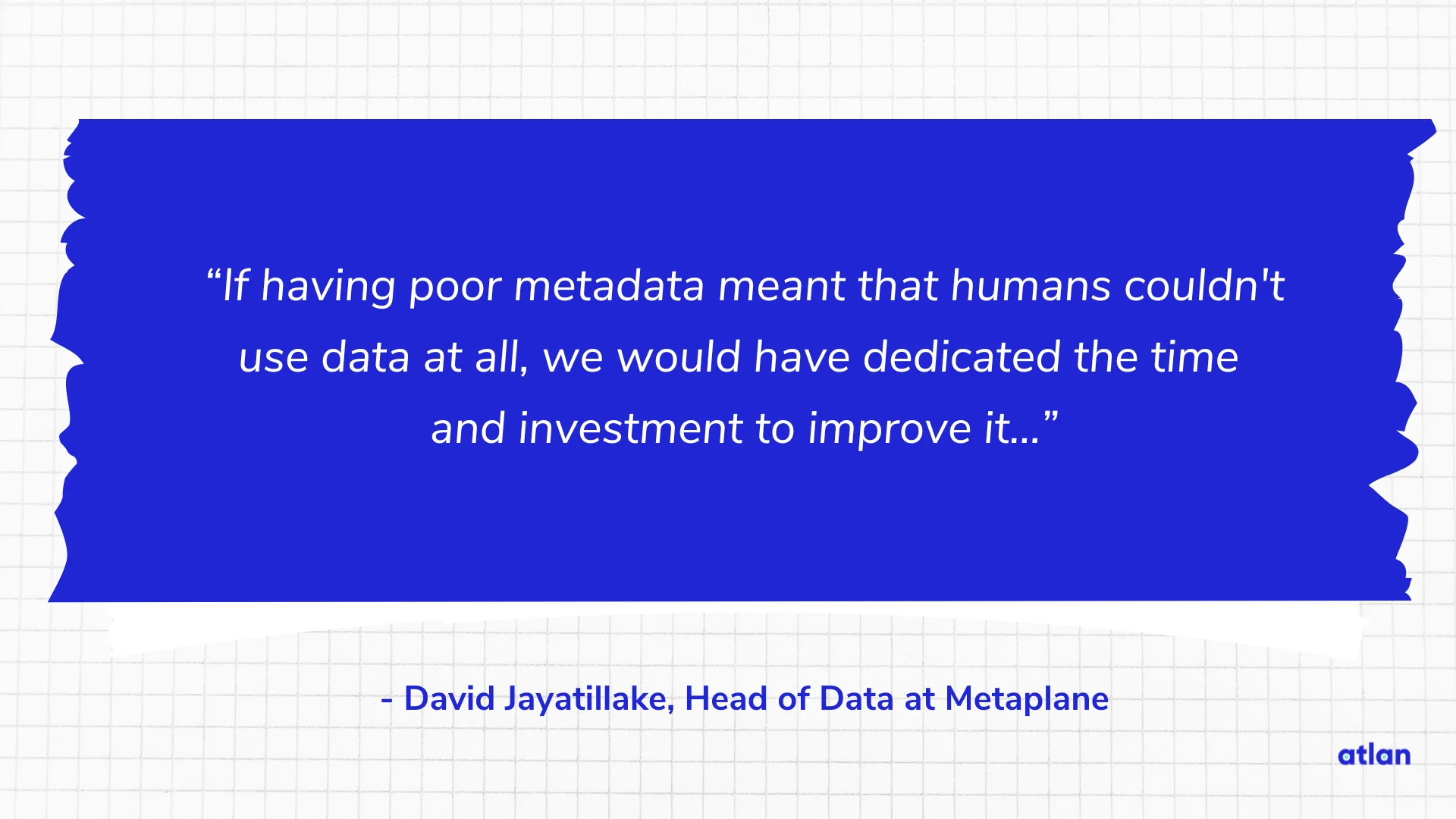
Having poor metadata meant that humans couldn't use data at all - Source: David Jayatillake.
Metadata management is at the heart of ensuring the effectiveness of enterprise AI.
What does this translate to in terms of technology? In modern data architecture, this involves establishing a data ecosystem that integrates metadata standards, tools, and automation:
- Implement metadata standards: This includes defining metadata schema, standardizing business terminology, adopting industry standards for metadata governance, tracing source lineage, and more. These standards lend consistency, interoperability, and rich context to your data.
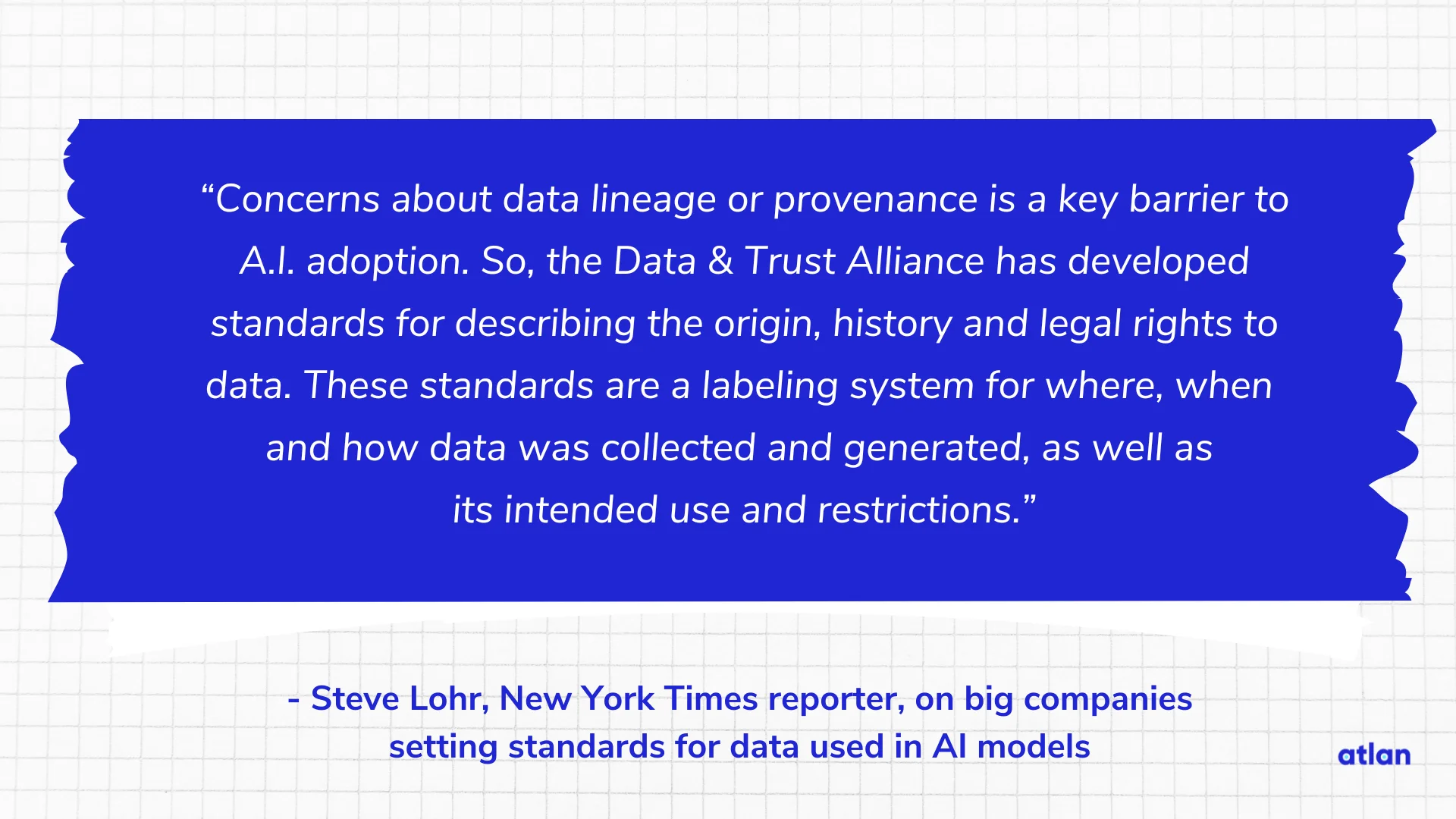
How big companies setting standards for data used in AI models - Source: Steve Lohr, New York Times reporter
- Use active metadata management tools: Choose metadata management tools that offer real-time, bidirectional sync of metadata across all systems. These tools should enable metadata capture, lineage tracking, governance workflows, and more at scale — vital for valuable insights into data quality, impact analysis, and regulatory compliance.
Dig deeper → Active metadata management platform for your data stack
- Leverage automation: Automation saves time, reduces human errors, and enables enterprise deployments at scale. You can leverage automation for processes such as:
- Metadata ingestion
- Metadata tagging
- Lineage mapping
- Documentation (READMEs, summaries, asset descriptions)
- Assigning ownership of data assets
- Data quality checks
- Anomaly detection
- Data governance and compliance — policy enforcement, access controls, and audit trails
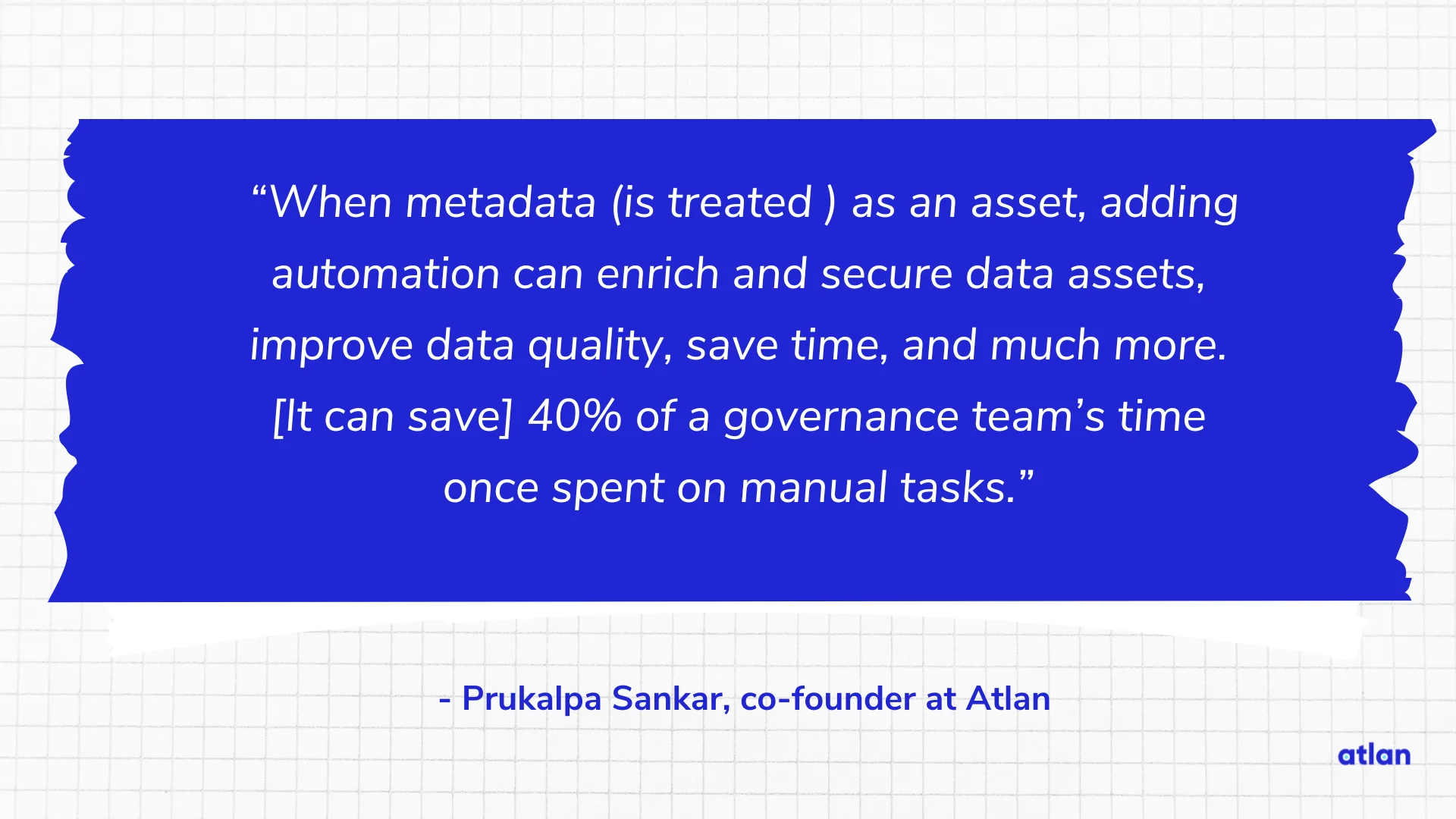
Adding automation can enrich and secure data assets, improve data quality, save time - Source: Prukalpa Sankar, co-founder at Atlan.
Dig deeper → Automated metadata management 101
The above aspects make sure that your data assets are relevant, accessible, discoverable, trustworthy, secure, and observable. This sets the stage for successful AI deployments — more relevant, accurate, meaningful, and valuable outcomes.
Summing up: The role of metadata management in enterprise AI is critical #
The role of metadata management in enterprise AI is often underrated. However, it is central to ensuring AI models generate accurate, ethical, and useful outcomes.
Investing in modern metadata management platforms is necessary for enterprises aiming to harness the power of AI. By embracing active metadata management, organizations can unlock the full potential of their data, drive innovation, and stay ahead of the competition.
Role of Metadata Management in Enterprise AI: Related Reads #
- What is Active Metadata? — Definition, Characteristics, Example & Use Cases
- AI Data Catalog: Its Everything You Hoped For & More
- 8 AI-Powered Data Catalog Workflows For Power Users
- Data Governance for AI
- AI Data Governance: Why Is It A Compelling Possibility?
- Atlan AI for data exploration
- Atlan AI for lineage analysis
- Atlan AI for documentation
Share this article











